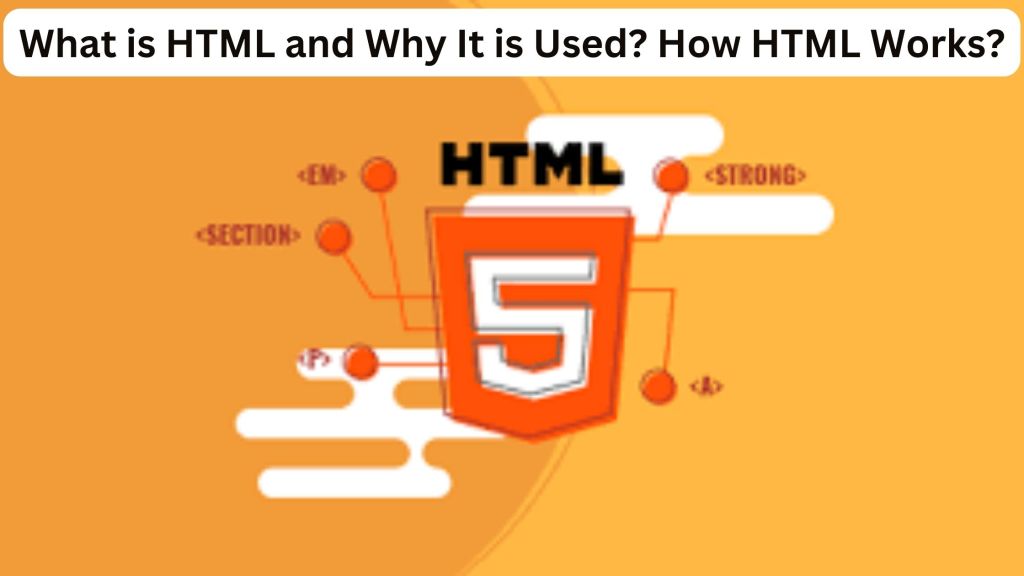HTML, or HyperText Markup Language, is the standard markup language used to create web pages. HTML is used to structure the content of a web page and can be used to include images, videos, and other multimedia. HTML is written in plain text and can be read by any web browser.
HTML has a lot of use cases, Namely?
- Web development: HTML code is used by developers to create the way in which a browser displays the elements of a web page, including text, hyperlinks, and media files.
- Internet navigation: Because HTML is commonly used to embed hyperlinks, users may simply move between similar pages and websites and add links to those pages and websites.
- Web documentation: Documents can be organised and formatted using HTML in a manner comparable to that of Microsoft Word.
How Does the HTML Work?
The typical website is comprised of a number of uniquely formatted HTML pages. For illustration’s sake, a home page, an about page, and a contact page would each have their own individual HTML file.
Documents written in HTML are denoted by filenames that finish in either.html or.htm. The HTML file is read by a web browser, which then renders the content of the file so that users of the internet can access it.
Each and every HTML page contains a number of HTML components, which are made up of a collection of tags and attributes. HTML elements are the fundamental components that make up a web page. The purpose of a tag is to inform the web browser of the beginning and ending locations of an element, while the purpose of an attribute is to describe the properties of an element.
The following are the three primary components of an element:
- The opening tag: Indicates the point at which the influence of an element is first felt. The tag has opening and closing angle brackets around it on all sides. To build an example paragraph, for instance, you would use the start tag <p> to create a paragraph.
- Content: Content is the output that is viewed by other users of the system.
- The closing tag: The Closing tag is the same as the opening tag, except that it includes a forward slash (/) before the name of the element. For example, you might use </p> to finish a paragraph.
What are the Connections Between HTML, CSS, and Javascript?
In order to construct the structure of the material and add text parts, HTML is utilized. Despite this, constructing a website that is both professional and fully responsive is not sufficient. Therefore, in order to construct the vast majority of the content found on websites, HTML requires assistance from Cascading Style Sheets (CSS) and JavaScript.
The Cascading Style Sheet (CSS) is in charge of styling, which includes the background, colors, layouts, spacing, and animations. On the other hand, JavaScript offers dynamic functionality to a website, which can include sliders, pop-ups, and photo galleries. The front-end development process cannot exist without these three languages at its core.
Understanding of HTML and Developing Your Skills in HTML
Studying the hypertext markup language (HTML) is an excellent way to get started in the field of web development.
There is a plenty of Online courses available online to learn code; nevertheless, the following three instructional databases for HTML are considered to be the best of the best.
- WsCube Tech: WsCube Tech is a website that offers an online web development course in which you can learn complete HTML with examples. This course will teach you everything you need to know about HTML, from the basics to more advanced concepts. You’ll learn how to create and format web pages, as well as how to add multimedia and interactivity. By the end of the course, you’ll be able to build your own web pages from scratch.
- W3Schools: W3Schools is a website that offers free assistance in learning fundamental HTML by providing materials, examples, and exercises. In addition, there is a self-guided HTML course that can be purchased for $95 and results in official certification.
- Codecademy: Codecademy is a website that provides beginners with free introductory courses that include interactive tutorials. Codecademy makes use of a split-screen interface that immediately displays the output of your code in the form of an HTML file. If you pay $19.99 per month, you get access to the exclusive stuff.
- Coursera: Coursera is an online education platform that provides a variety of courses that offer in-depth explanations and examples from real life. The cost of the subscription is $49 per month, and users can begin with a free trial that lasts for 7 days.
Conclusion
The majority of websites on the internet use HTML as their primary markup language. A web page or application, whether it is a web page or an application, is composed of a sequence of parts that are found on every HTML page.
HTML is a language that is great for beginners because it has a lot of available assistance and is primarily used for creating static web pages. The best results can be achieved when HTML is used in conjunction with CSS for formatting and JavaScript for functionality. On our blog, you’ll find detailed instructions on how to link CSS and HTML.
We have also provided you with information regarding some of the best online courses that are now available and will either assist you in enhancing your existing knowledge of HTML or offer you a fundamental comprehension of it.
Please let us know in the comments area if you are familiar with any further helpful sites for learning HTML. Best of luck.

